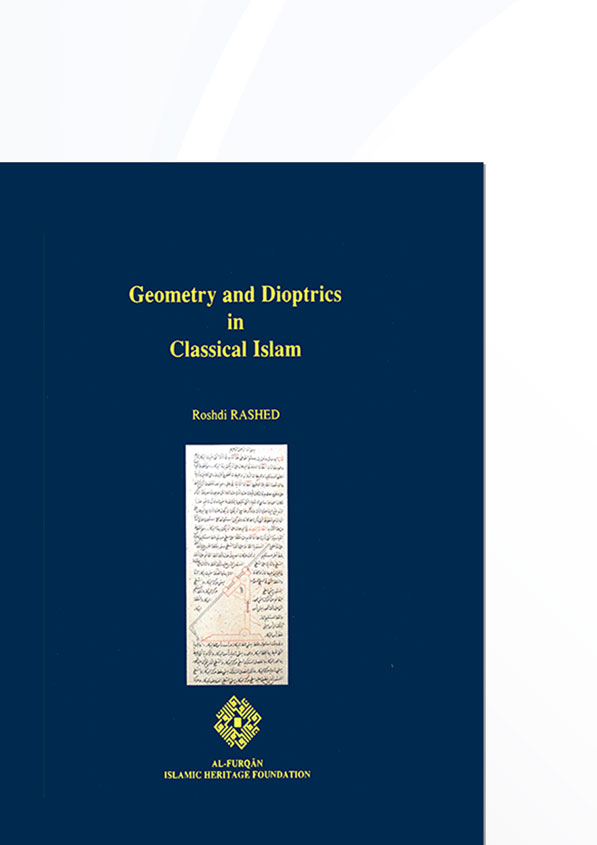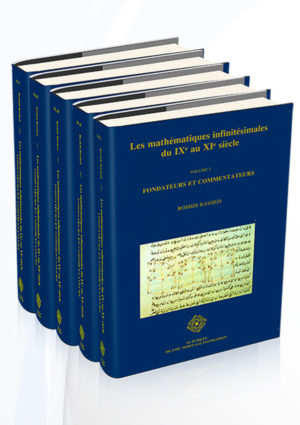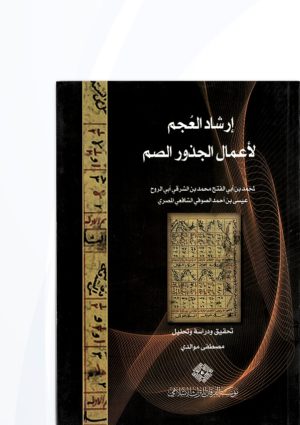PREFACE OF THE TRANSLATION
NOTICE
CHAPTER I: THE MATHEMATICIANS: SCIENTIFIC MILIEU AND WORKS
1. Ibn Sahl
1.1. Ibn Sahl and his Time
1.2. Ibn Sahl’s Scientific Work
1.2.1. On Squaring the Parabola
1.2.2. On Centers of Gravity
1.2.3. Geometrical Problems Cited by al-Sijzī
1.2.4. On Lines of Diorism
1.2.5. Al-Shannī s Book on the Synthesis of the Problems Ana-lysed by Abū Saʻd al-ʻAlāʼ ibn Sahl
1.2.6. On the Properties of the Three Conic Sections
1.2.7. The Book on the Astrolabe by the Demonstration of al-Qūhī and the Commentary of Ibn Sahl
1.2.8. Burning Instruments
1.2.9. Proof that the Celestial Sphere is not of extreme Transparency
2. Al-Qūhī
2.1. The Mathematician and the Artisan
2.2. Al-Qūhī's Scientific Work
2.2.1. The Book on the Astrolabe by Demonstration
2.2.2. On the Perfect Compass
2.2.3. Lemma to the Division of the Straight Line by Archimedes
2.2.4. On the Construction of an Equilateral Pentagon in a Given Square
2.2.5. On the Determination of the Division of a Known Angle into Three Equal Parts
2.2.6. On the Division of an Angle Enclosed by Two Straight Lines into Three Equal Parts
2.2.7. On the Determination of Two Straight Lines Between Two Straight Lines, so that the Four Succeed One Another in Continuous Proportion, and on the Division of an Angle into Three Equal Parts
2.2.8. On the Trisection of an Angle and the Construction of a Regular Heptagon in the Circle
2.2.9. On the Knowledge of the Magnitude of the Distance between the Center of the Earth and the Position of a Shooting Star in the Night
2.2.10. On the Knowledge of the Magnitude of what is Seen of the Sky and of the Sea from the Top of an Elevated Thing
2.2.11. In Finite Time, there is Infinite Movement
3. Al-Qūhī's Predecessors: On the Trisection of an Angle
3.1. Aḥmad ibn Shākir: On the Trisection of an Angle Enclosed by Two Straight Lines
3.2. Thābit ibn Qurra
3.2.1. On the Construction of Two Means and the Division of a Known Angle into Three Equal Parts
3.2.2. The Division of an Angle into Three Equal Parts
3.3. Abū Ja'far Muḥammad ibn al-Ḥusayn al-Khāzin
3.3.1. On the Division of an Angle into Three Equal Parts and the Determination of Two Straight Lines Between Two Straight Lines that Succeed One Another in Continuous Proportion
3.3.2. On the Determination of Two Straight Lines Between Two Straight Lines that Succeed One Another in Continuous Proportion by a Method of Fixed Geometry
4. Al-Sijzī
4.1. On the Construction of the Perfect Compass
4.2. On the Properties of the Hyperbolic Dome and the Parabolic Dome
4.3. On the Properties of the Elliptical, Hyperbolic and Parabolic Solids
5. Ibn al-Haytham
5.1. Book Seven of the Optics
5.2. The Treatise on the Burning Sphere
6. Al-Fārisī: The Commentary on the Burning Sphere
Dioptrics
CHAPTERS II: IBN SAHL AND THE BEGINNINGS OF DIOPTRICS
1. Introduction
2. The Parabolic Mirror
3. The Ellipsoidal Mirror
4. Refraction and Snell's Law
5. Plano-Convex and Biconvex Lenses
6. Conclusion
TEXTS AND TRANSLATION
1. On Burning Instruments
2. Proof that the Celestial is not of Extreme Transparency
CHAPTER III: THE DIOPTRICAL RESEARCH OF IBN AL-HAYTHAM AND AL-FĀRSĪ
1. The Spherical Diopter
2. The Spherical Lens
3. The Burning Sphere
4. The Burning Sphere and the Quantitative Study of al-Fārisī
5. Ibn Sahl, Ibn al-Haytham, and Snell's Law
TEXTS AND TRANSLATION
Ibn al-Haytham
1. Optics – Seventh Book: The Spherical Diopter
2. Optics – Seventh Book: The Spherical Lens
3. Treatise on the Burning Sphere
4. Treatise on the Burning Sphere – Redaction of al-Fārisī
Geometry
CHAPTER IV: ON CONIC SECTIONS AND THEIR APPLICATIONS
1. Conics and Harmonic Division
1.1. Ibn Sahl on Harmonic Division
1.2. Projective Interpretation of Ibn Sahl's Study
2. Ibn Sahl on Conic Sections and Geometrical Constructions
2.1. The Synthesis by al-Shannī of Ibn Sahl's Analysis of Geometrical Problems
2.2. Ibn Sahl on the Construction of a Triangle by Means of an Ellipse and a Circle
3. Conic Sections and Geometrical Construction: al-Qūhī and his Predecessors
3.1. Introduction
3.2. The Two Mean Proportionals
3.2.1. The Legacy of the Ancients
3.2.2. The New Tradition: Thābit ibn Qurra and al-Khāzin
3.2.3. AL-Qūhī
3.3. The Trisection of an Angle
3.3.1. Introduction
3.3.2. The Earliest Trisections of an Angle: Pappus, Aḥmad ibn Shāktr and Thābit ibn Qurra
3.3.3. Al-Khāzin: Trisecting an Angle and the Cleavage between Ancients and Moderns
3.4. Al-Qūhī: Variation on the Trisection of an Angle
3.5. The Lemma to Archimedes' Division of a Straight Line
3.6. The Inscription of a Pentagon in a Given Square
3.7. Conclusion
4. A New Orientation in the Geometry of Conics: Quadratic Surfaces
4.1. On the Properties of Hyperbolic and Parabolic Domes
4.2. Projective Interpretation of the Problem of the Plane Sections of a Quadric
4.3. On the Properties of Elliptical, Hyperbolic and Parabolic Solids
4.3.1. Plane Sections
4.3.2. Hyperbolic and parabolic Plane Sections
4.4. The Projective Interpretation of the Investigation of Plane Sections of a Cylinder
TEXTS AND TRANSLATION
Ibn Sahl
1. On the Properties of the Three Conic Sections
2. Book on the Synthesis of the Problems Analysed
3. A Fragment on the Construction of a Triangle by Means of an Ellipse and a Circle
4. A Problem of Geometry
AL-QŪHī
1. On the Determination of the Division of a Known Angle into Three Equal Parts
2. On the Division of an Angle Enclosed by Two Straight Lines into Three Equal Parts
3. On the Determination of Two Straight Lines Between Two Straight Lines, so that the Four Succeed One Another in Continuous Proportion, and on the Division of an Angle into Three Equal Parts
4. On the Trisection of an Angle and the Construction of a Regular Heptagon in the Circle
5. Lemma to the Division of the Straight Line by Archimedes
6. On the Construction of an Equilateral Pentagon in a Given Square
AL-QŪHī'S PREDECESSORS
1. Aḥmad ibn Shākir
On the Trisection of an Angle Enclosed byTwo Straight Lines
2. Thābit ibn Qurra
On the Construction of Two Means and the Division of a Known Angle into Three Parts
The Division of an Angle Enclosed by Two Straight Lines into Three Equal Parts
3. AL-Khāzin
The Division of an Angle into Three Equal Parts and the Determination of Two Straight Lines Between Two Straight Lines that Succeed One Another in Continuous Proportion
On the Determination of two Straight Lines Between Two Straight Lines that Succeed in One Another in Continuous Proportion by a Method of Fixed Geometry
AL-SUZĪ
On the Properties of the Hyperbolic Dome and the Parabolic Dome
On the Properties of the Elliptical, Hyperbolic and Parabolic Solids
CHAPTER V: A TRADITION OF RESEARCH: CONTINUOUS DRAWING OF CONIC CURVES AND THE PERFECT COMPASS
Introduction
1. The Mechanical Construction of Conics Ibn Sahl
1.1. The Parabola
1.2. The Ellipse
1.3. The Hyperbola
2. The Invention of the Perfect Compass: Abū Sahl al-Qūhī
2.1. Al-Qūhī's First Book
2.2. Al-Qūhī's Second Book
2.3. Correspondence between al-Qūhī's propositions 4, 5, and 6 and proposition I.52 TO 59 of Apollonius' Conics
3. Al-sijzī and the Continuous Drawing of Similar Conic Sections with the Help of the Perfect Compass
4. Continuous Drawing and the Classification of Curves
5. Geminus and al-Sijzī: the Classification of Curves
6. Ibn 'Irāq and al-Bīrūnī on al-Qūhī's Perfect Compass
6.1. Ibn 'Irāq: on the Lemmas of al-Qūhī
6.2. Al-Bīrūnī: al-Qūhī's Theory of the Perfect Compass
6.2.1. The Parabola
6.2.2. The Hyperbola
6.2.3. The Ellipse
7. Kamāl al-Dīn ibn Yūnus and his Pupils: On the Perfect Compass
7.1. Introduction
7.2. Al-Abharī and the Perfect Compass
8. Conclusion: Drawing Conic Sections: A New Subject Area in Geometry
TEXTS AND TRANSLATION
1. Al-Qūhī: On the perfect Compass
2. Al-Sijzī: On the Construction of the Perfect Compass
3. Ibn 'Irāq: Epistle of Ibn 'Irāq to al-Bīrūnī in Reply to Geometrical Problems
4. Al-Bīrūnī: Account of the Perfect Compass
5. Al-Abharī: Treatise on the Compass of Conic Sections
CHAPTER VI: CONICAL AND CYLINDERICAL AL PROJECTIONS, AND ASTROLABES
1. The Astrolabe and the Methods of Projection
2. Ibn Sahl on Stereographic Projection
TEXTS AND TRANSLATION
1. Treatise on the Art of the Astrolabe by Demonstration, composed by Al-Qūhī
2. Ibn Sahl: Commentary on the Treatise on the Art of the Astrolabe by Al- al-Qūhī
3. A Fragment of Ibn Sahl on Stereographic Projection
APPENDIX I: GEOMETRY AND MECHANICS (KINEMATICS). AL-QŪHĪ, VS ARISTOTLE ON MOTION
TEXTS AND TRANSLATION
1. Al-Qūhī: In Finite Time, there is Infinite Movement
2. Fragment of the Treatise of Ibn Buṭlān: The Refutations of 'Ali ibn Riḑwān
3. Fragment of al-Mu'tabar fi al-ḥikma of Abū al-Barakāt al-Baghdādī
APEENDIX II: AL-QŪHĪ: FROM METEOROLOGY TO ASTRONOMY
TEXTS AND TRANSLATION
1. On the Knowledge of the Magnitude of the Distance between the Center of the Earth and the Position of a Shooting Star in the Night
2. On the Knowledge of the Magnitude of what is Seen of the Sky and OF the Sea from the top of an Elevated Thing
3. Fī ma'rifat mā yurā min al-samā' wa-al-baḥr (abridged version)
ADDITIONAL NOTES
Notes on Ibn Sahl's Treatises on Burning Instruments and the Celestial Sphere
1. On the parts of the ’instrument’
2. Experimentation
3. Translation of Plotemy's Optics
Notes on Ibn al-Haytham's On the Sundial
Notes on al-Shannī's Book on Synthesis
Notes on the Astrolabe
1. Treatise by al-Qūhī
2. Ibn Sahl's Commentary on the treatise by al-Qūhī
ARABIC-ENGLISH GLOSSARY
INDEX
Index of Names
Subject Index
Index of works
Index of Manuscripts
BIBLIOGRAPHY
ARABIC PREFACE






Agha wajahat –
good